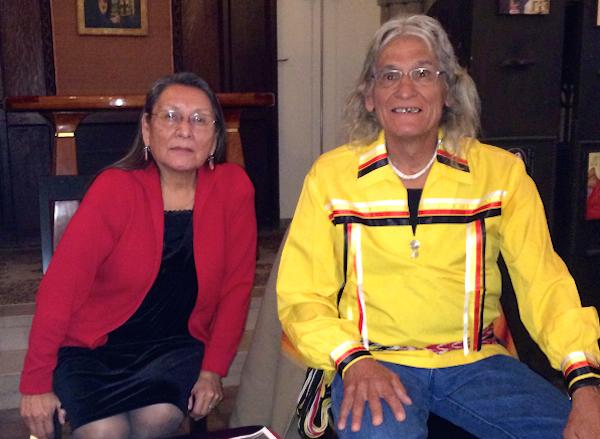Mohawk and Lakota Activists Light Fire for Climate Action

Loretta Afraid-of-Bear Cook, Lakota, and Tom Kanatakeniate Cook, Mohawk, visited Union Theological Seminary in April and
Karenna Gore, The Union Forum
The dispossession of Native peoples, the exploitation of land for resources and profit, and the suppression of indigenous spiritual practices have always operated in concert.
In a visit to Union last month, Tom Kanatakeniate Cook and Loretta Afraid-of-Bear Cook explored this connection as they shared some of their history and spiritual traditions. The practices they shared in Lampman Chapel, mindful of both nature and ancestry, evoked an implicit understanding of how intergenerational moral obligations are inextricably bound to respectful treatment of the Earth.
The Cooks also visited with several Union professors, attended the chapel service Speak Upon the Ashes (led by participants in the 2014 Samuel DeWitt Proctor conference which nurtures, mobilizes and sustains African-American faith communities), talked with students more informally in the Social Hall, and provided wise counsel to those working on the conference Union will host in September: “Religions for the Earth: Spirituality and Faith-Based Action on Climate Change.” From their point of view, a good start to any initiative on climate would be to return the care of the sacred sites of the earth to the indigenous peoples who revere them.
Their heritage runs deep. Loretta’s mother and aunt (Beatrice and Rita Long Visitor Holy Dance) are members of a recently formed group called the Thirteen Indigenous Grandmothers who call for a “global alliance of prayer, education and healing for our Mother Earth.” Loretta, a Lakota elder who is also the great-granddaughter of Chief American Horse, explained that she is currently focused on two goals: the return of the sacred Black Hills (in South Dakota) to the Lakota and convincing the Vatican to rescind the fifteenth century papal bulls that expressly called for the devastation of Native Americans.
In 1455, Pope Nicholas V issued the bull Romanus Pontifex in order to allow Portugal to claim land and “capture, vanquish and subdue” the non-Christians in Africa. On May 3, 1493, Pope Alexander VI issued a bull extending this right to Spain which was already busy colonizing the Americas, treating its people and its natural resources with the same proprietary hunger. On May 4, 1493, the very next day (who says the Vatican can’t do things quickly?), he responded to Portugal’s competitive complaint by issuing a follow-up bull—Inter Caetera—stipulating that Spain would of course not be allowed to take any lands claimed already by Portugal — or in other words, land that had come into the “possession of Christian Lords.” The United States legal system drew on this as precedent in establishing what has become known as the “Doctrine of Discovery.”
RELATED: Vatican Releases Tantalizing Glimpse into Papal Documents About Columbus
There could hardly be a more poignant statement of the impact of the Doctrine of Discovery than the presence of Mount Rushmore in the sacred Black Hills. Even the name derives from the extractionist industries that drive the release of carbon emissions. The WPA state guidebook for South Dakota tells the story of the name this way: “Following the gold rush period of the late 1870′s, Charles E. Rushmore, an attorney from New York, visited the Black Hills in the interests of his mining clients. While touring the Hills, by horse and buggy, the attorney inquired the name of the granite crusted mountain. One of the party jokingly answered: ‘Why that is Mount Rushmore.’ And it still bears that name.”
Read more at http://indiancountrytodaymedianetwork.com/2014/05/12/mohawk-and-lakota-activists-light-fire-climate-action-154841
